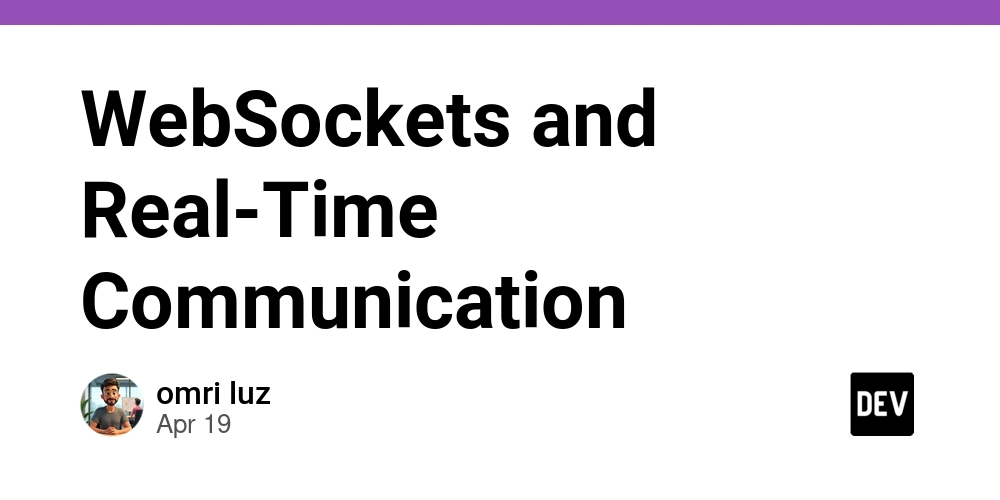WebSockets and Real-Time Communication
WebSockets and Real-Time Communication: An Advanced Technical Exploration Introduction As the web continues to evolve, the demand for real-time communication has become increasingly paramount. Traditional HTTP protocols, characterized by their request-response model, have proven inadequate for scalable real-time applications. This inadequacy leads to the proliferation of technologies like WebSockets. This article will provide an exhaustive exploration of WebSockets, their history, technical specifications, real-world applications, and advanced implementation techniques. We'll reveal complex code examples, performance optimizations, and advanced debugging strategies that developers can employ in their applications. Historical and Technical Context Evolution of Real-Time Communication The need for real-time communication on the web began to manifest in the early 2000s. Before the introduction of new protocols, developers faced challenges with existing technologies, most prominently: Polling - Regularly checking the server for updates (e.g., via AJAX), leading to reduced efficiency and increased load. Long Polling - A workaround to simulate real-time communication, involving a request to the server that remains open until the server has new information. While somewhat better than polling, it still incurs the overhead of opening a new connection after receiving data. Server-Sent Events (SSE) - A unidirectional communication channel allowing servers to push updates to clients. While lesser in terms of flexibility, it only supports text-based data and one-directional communication. The introduction of the WebSocket protocol by IETF, standardized as RFC 6455 in 2011, revolutionized the space by allowing full-duplex communication channels over a single TCP connection. This laid the foundation for more efficient and scalable real-time web applications. Technical Specifications of WebSockets WebSockets operate over a single persistent connection, reducing the overhead of HTTP request headers associated with opening and closing connections. The protocol includes: Handshaking: Transitioning from HTTP to WebSocket begins with an "upgrade" request initiated by the client when it requests a connection. This is typically done using JavaScript’s WebSocket API. const socket = new WebSocket('ws://example.com/socket'); socket.onopen = (event) => { console.log("WebSocket is open now."); }; Data Frames: Once the connection is established, the data transmission occurs through frames which can be of different types (text or binary). Closing Handshake: Similar to the connection initiation, when either side wishes to close the connection, they can initiate a closure handshake (via a close frame). Code Example: Building a Chat Application with WebSockets Let's explore a practical implementation of a chat application using WebSockets. // Client-side code const socket = new WebSocket('ws://localhost:3000'); socket.onopen = () => { console.log("Connected to the chat server"); socket.send("Hello Server!"); }; socket.onmessage = (event) => { const message = JSON.parse(event.data); console.log(`Received: ${message.username}: ${message.text}`); }; socket.onclose = () => { console.log("Disconnected from the chat server"); }; // Sending a message from an input field document.getElementById('sendButton').onclick = () => { const input = document.getElementById('messageInput'); const message = { text: input.value, username: 'User1' }; socket.send(JSON.stringify(message)); input.value = ''; // Clear input field }; Server-Side Implementation For the server-side, we can use Node.js with the ws library. // Server-side code const WebSocket = require('ws'); const server = new WebSocket.Server({ port: 3000 }); server.on('connection', (socket) => { console.log('New client connected'); socket.on('message', (message) => { // Broadcast to all connected clients server.clients.forEach(client => { if (client.readyState === WebSocket.OPEN) { client.send(message); } }); }); socket.on('close', () => { console.log('Client disconnected'); }); }); Advanced Implementation Techniques Subprotocols and Authentication WebSocket connections support subprotocols, allowing the server and client to agree on how the data will be formatted. When establishing a WebSocket connection, clients can specify the subprotocols they support. For example: const socket = new WebSocket('ws://localhost:3000', 'chat-protocol'); On the server-side, you handle this as follows: server.on('connection', (socket, request) => { const protocol = request.headers['sec-websocket-protocol']; // Validate subprotocols provided }); Authentication can be essential in real

WebSockets and Real-Time Communication: An Advanced Technical Exploration
Introduction
As the web continues to evolve, the demand for real-time communication has become increasingly paramount. Traditional HTTP protocols, characterized by their request-response model, have proven inadequate for scalable real-time applications. This inadequacy leads to the proliferation of technologies like WebSockets. This article will provide an exhaustive exploration of WebSockets, their history, technical specifications, real-world applications, and advanced implementation techniques. We'll reveal complex code examples, performance optimizations, and advanced debugging strategies that developers can employ in their applications.
Historical and Technical Context
Evolution of Real-Time Communication
The need for real-time communication on the web began to manifest in the early 2000s. Before the introduction of new protocols, developers faced challenges with existing technologies, most prominently:
- Polling - Regularly checking the server for updates (e.g., via AJAX), leading to reduced efficiency and increased load.
- Long Polling - A workaround to simulate real-time communication, involving a request to the server that remains open until the server has new information. While somewhat better than polling, it still incurs the overhead of opening a new connection after receiving data.
- Server-Sent Events (SSE) - A unidirectional communication channel allowing servers to push updates to clients. While lesser in terms of flexibility, it only supports text-based data and one-directional communication.
The introduction of the WebSocket protocol by IETF, standardized as RFC 6455 in 2011, revolutionized the space by allowing full-duplex communication channels over a single TCP connection. This laid the foundation for more efficient and scalable real-time web applications.
Technical Specifications of WebSockets
WebSockets operate over a single persistent connection, reducing the overhead of HTTP request headers associated with opening and closing connections. The protocol includes:
-
Handshaking: Transitioning from HTTP to WebSocket begins with an "upgrade" request initiated by the client when it requests a connection. This is typically done using JavaScript’s
WebSocketAPI.
const socket = new WebSocket('ws://example.com/socket');
socket.onopen = (event) => {
console.log("WebSocket is open now.");
};
Data Frames: Once the connection is established, the data transmission occurs through frames which can be of different types (text or binary).
Closing Handshake: Similar to the connection initiation, when either side wishes to close the connection, they can initiate a closure handshake (via a close frame).
Code Example: Building a Chat Application with WebSockets
Let's explore a practical implementation of a chat application using WebSockets.
// Client-side code
const socket = new WebSocket('ws://localhost:3000');
socket.onopen = () => {
console.log("Connected to the chat server");
socket.send("Hello Server!");
};
socket.onmessage = (event) => {
const message = JSON.parse(event.data);
console.log(`Received: ${message.username}: ${message.text}`);
};
socket.onclose = () => {
console.log("Disconnected from the chat server");
};
// Sending a message from an input field
document.getElementById('sendButton').onclick = () => {
const input = document.getElementById('messageInput');
const message = {
text: input.value,
username: 'User1'
};
socket.send(JSON.stringify(message));
input.value = ''; // Clear input field
};
Server-Side Implementation
For the server-side, we can use Node.js with the ws library.
// Server-side code
const WebSocket = require('ws');
const server = new WebSocket.Server({ port: 3000 });
server.on('connection', (socket) => {
console.log('New client connected');
socket.on('message', (message) => {
// Broadcast to all connected clients
server.clients.forEach(client => {
if (client.readyState === WebSocket.OPEN) {
client.send(message);
}
});
});
socket.on('close', () => {
console.log('Client disconnected');
});
});
Advanced Implementation Techniques
Subprotocols and Authentication
WebSocket connections support subprotocols, allowing the server and client to agree on how the data will be formatted.
When establishing a WebSocket connection, clients can specify the subprotocols they support. For example:
const socket = new WebSocket('ws://localhost:3000', 'chat-protocol');
On the server-side, you handle this as follows:
server.on('connection', (socket, request) => {
const protocol = request.headers['sec-websocket-protocol'];
// Validate subprotocols provided
});
Authentication can be essential in real-time applications. You might choose to authenticate users before they establish a WebSocket connection. This could involve token-based authentication where users are required to provide a valid JWT as a query parameter during the handshake.
const socket = new WebSocket('ws://localhost:3000?token=user_jwt_token');
On the server:
server.on('connection', (socket, request) => {
const params = new URLSearchParams(request.url.split('?')[1]);
const token = params.get('token');
if (!validateToken(token)) {
socket.close(); // Close the connection if token is invalid
} else {
// Allow connection...
}
});
Performance Considerations and Optimization Strategies
Connection Management
Establishing and tearing down connections incurs overhead, so it’s important to minimize unnecessary connections. Keeping connections alive, reusing connections, and efficiently managing connection lifetimes can significantly improve performance.
Load Balancing
In larger applications, employing a load balancer that handles WebSocket connections is essential. Technology such as AWS Elastic Load Balancing or NGINX can manage distribution but require sticky sessions or affinity configuration since WebSocket connections maintain a state.
Message Throttling and Debouncing
In scenarios where high-frequency messages are common, you might want to implement throttling or debouncing mechanisms to avoid flooding clients with data.
let timeout;
function sendMessageDebounce(message, delay) {
clearTimeout(timeout);
timeout = setTimeout(() => socket.send(message), delay);
}
Comparing WebSockets with Alternative Approaches
WebSocket vs. HTTP/2 Server Push
While HTTP/2 allows multiplexed streams over a single connection, it relies on a request-response model. In contrast, WebSockets provide full-duplex communication, making them more suitable for low-latency applications, such as live chat or gaming.
WebSocket vs. Server-Sent Events (SSE)
SSE is excellent for unidirectional updates from server to client, especially in applications like dashboards or notifications. However, for interactive applications requiring bidirectional data flow, WebSockets are superior.
Real-World Use Cases
Collaboration Tools: Applications like Trello utilize WebSockets for real-time updates, enabling multiple users to interact with the same data set without refreshes.
Live Sports Updates: Sports websites can deliver real-time score updates and commentary without the overhead of polling.
Online Gaming: Many multiplayer games utilize WebSockets to achieve low-latency and bidirectional communication, allowing players to interact with the game world in real-time.
Potential Pitfalls
Network Reliability: WebSocket connections can drop due to network issues. Implement automatic reconnections with exponential backoff strategies to enhance user experience.
Scalability: Managing state across multiple WebSocket connections becomes complex as application scale increases. Consider using Pub/Sub patterns or distributed message brokers like Redis or RabbitMQ.
Security Risks: Be vigilant about XSS attacks, man-in-the-middle (MITM) attacks, and ensure that you’re communicating over
wss(WebSocket Secure) whenever possible.
Debugging Techniques
Browser Developer Tools: Utilize the networking tab in Chrome/Firefox for monitoring WebSocket frames and to visualize frame content over a connection.
Logging: Implement logging of connection states, message receipt, and errors both on the client and server-side to track down issues.
Memory Profiling: Because WebSocket applications can stay open for extended periods, running memory profiling tools (e.g., Chrome DevTools) can help identify memory leaks.
Conclusion
WebSockets have transformed the landscape of real-time web applications. Understanding the intricacies of their implementation can significantly elevate a developer’s proficiency, primarily when dealing with collaborative applications or those requiring real-time interaction.
By delving into subprotocols, performance optimizations, and potential pitfalls, this definitive guide aims to provide senior developers with the tools and understanding required to leverage WebSockets in advanced scenarios.
References
- Official WebSocket Documentation: MDN WebSocket
- RFC 6455 Specification: RFC 6455
-
Node.js
wsLibrary Documentation: ws GitHub - Advanced WebSocket Patterns: WebSockets in 100 Seconds
This exploration offers insights and practical examples that can guide senior developers towards mastering WebSockets and implementing them effectively within their real-time applications. With advancements continually shaping this field, staying informed is crucial for future-proofing your applications.








































































